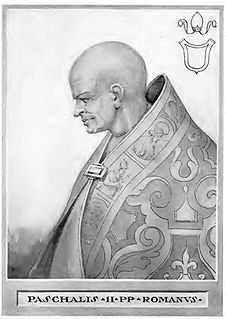Related Research Articles
Gregory VIII, born Alberto di Morra, was head of the Catholic Church and ruler of the Papal States for two months in 1187.

Pope Callixtus II or Callistus II, born Guy of Burgundy, was head of the Catholic Church and ruler of the Papal States from 1 February 1119 to his death in 1124. His pontificate was shaped by the Investiture Controversy, which he was able to settle through the Concordat of Worms in 1122.

Pope Paschal II, born Ranierius, was head of the Catholic Church and ruler of the Papal States from 13 August 1099 to his death in 1118. A monk of the Abbey of Cluny, he was created the cardinal-priest of San Clemente by Pope Gregory VII (1073–85) in 1073. He was consecrated as pope in succession to Pope Urban II (1088–99) on 19 August 1099. His reign of almost twenty years was exceptionally long for a medieval pope.

Ramon Berenguer IIIthe Great was the count of Barcelona, Girona, and Ausona from 1086, Besalú from 1111, Cerdanya from 1117, and count of Provence in the Holy Roman Empire, from 1112, all until his death in Barcelona in 1131. As Ramon Berenguer I, he was Count of Provence in right of his wife.

Dagobert was the first Archbishop of Pisa and the second Latin Patriarch of Jerusalem after the city was captured in the First Crusade.
Arnulf of Chocques was a leading member of the clergy during the First Crusade, being made Latin Patriarch of Jerusalem in 1099 and again from 1112 to 1118. Sometimes referred to as Arnulf of Rœulx, presumably after the village of Rœulx some 70km from his home village of Chocques, he was given the nickname Malecorne, meaning badly tonsured.
Bertrand of Toulouse was count of Toulouse, and was the first count of Tripoli to rule in Tripoli itself.
Gregory VIII, born Mauritius Burdinus, was antipope from 10 March 1118 until 22 April 1121.
Adalbert was elected pope of the Catholic Church in February 1101 and served for 105 days. He was a candidate of the Roman party opposed to Pope Paschal II and is regarded today as an antipope. Prior to his election he was created a cardinal by the antipope Clement III. He was captured by partisans of Paschal II and forced to live out his days as a monk.
Victor IV was an antipope for a short time in 1138.
Ghibbelin of Sabran was Archbishop of Arles (1080–1112), papal legate (1107–1108), and Latin Patriarch of Jerusalem (1108–1112).
Cuno of Praeneste was a German Cardinal and papal legate, an influential diplomatic figure of the early 12th century, active in France and Germany.

Gebhard III was Bishop of Constance and defender of papal rights against imperial encroachments during the Investiture Controversy.

Bernardo degli Uberti was an Italian Roman Catholic prelate who was a professed member and served as an abbot of the Vallumbrosan Order. Uberti served as the Bishop of Parma from 1106 until his death and was appointed as a cardinal. He came from the noble Uberti house from Florence. Uberti served as a papal legate for successive popes in several Italian regions in their disputes with secular rulers and was a close confidante and advisor to the Countess Matilda. He is often considered the third founding father for the order alongside Benedict of Nursia and Giovanni Gualberto.

Ehremar or Ebramar or Evremar was Latin Patriarch of Jerusalem from 1102 to 1105 or 1107, and then Archbishop of Caesarea.

The 1118 papal election saw the election of Pope Gelasius II as the successor of Pope Paschal II who died January 21, 1118, in Rome after an over 18-year pontificate. Gelasius died after only one year in the papacy.

Conrad I [of Abenberg] was Archbishop of Salzburg, Austria, in the first half of the 12th century.
Count Berengar II of Sulzbach, sometimes known as Berengar I of Sulzbach, was Count of Sulzbach in Bavaria. Berengar was a leader of the reform party. He sided with Pope Gregory VII during the Investiture Controversy in opposition to Henry IV, Holy Roman Emperor, and supported Henry V in his successful rebellion against his father. He is known as the founder of several abbeys.
Events during the year 1105 in Italy.
Maurice was the cardinal-bishop of Porto e Santa Rufina from between 1095 and 1099 until 1102. Following the success of the First Crusade, he was the apostolic legate in the Holy Land from 1100 until his death in 1102. From late 1101 he was also the acting patriarch of Jerusalem.
References
- ↑ Moroni 1852, p. 68.
- 1 2 Klewitz 1936, p. 216.
- ↑ Blumenthal 1978, p. 9.
- ↑ Rowe 1957, pp. 482–83.
- ↑ Blumenthal 1978, pp. 27–28.
- ↑ Robinson 1990, p. 103.